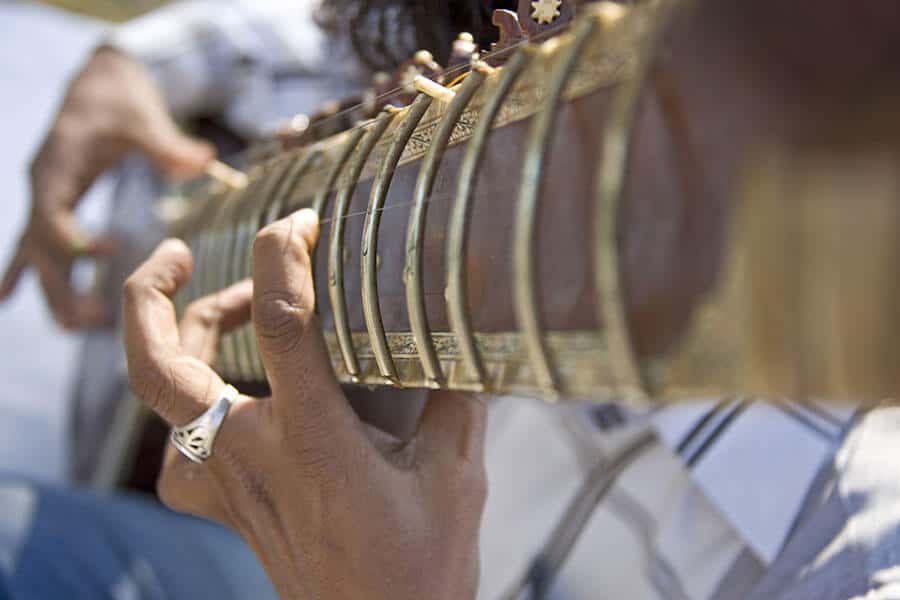Musical intelligence is graced through the beautiful stylings of Hindustani music! Although many variations and genres of Indian Music exist, classical music remains a key stylistic influence through today’s modern pop Indian music. Through Hindustani and Carnatic classical music, the listener can get a taste of pure enlightenment.
It still amazes me, the agility and strength music can have on various societies of the world. When someone is passionate about something, time is ordered around crafting a given love and advancing skill at a rapid and enjoyable pace. As you venture into musical culture on a global perspective, one can be amazed at how intricate in detail music can be. Music is a communal endeavor that sometimes takes a village to nurture, but when honed on the skills to make the most beautiful creations known to man, the musical language becomes universal.
No matter what walk of life you come from. A person can not be amazed and glorified by the level of musical intelligence Indian music proclaims. Unlike some traditional styles across the planet, the historical sounds of traditional Indian music have not lost touch with the modern generation. With the Asian regions of the world, it seems hard for the musical customs to fade. How so? It could be due to the power music has on their identities. A strong form of cultural identity is the essence of Hindustani and Carnatic music.
There are two distinct types of classical authentic Indian music. Hindustani (which derives from the North) and Carnatic (which is from the South). Hindustani music embodies various musical implications surrounding Turko-Persian descent. These musical elements are not as heavily implicated in Carnatic style. Styles or sub genres of well-known Hindustani styles include Thappu, Thumri, and Dhrupad. The classical music of India is heavily emphasized in Gharana which are schools of music. Traditional music has been passed on through generations of an oral nature and musical skills taught from a family relationship (father and son, teacher to student interaction). Some styles of Indian music correlate to specific faith. Kirtan and Bhajans are devotional Hindu styles while other styles such as qawwali is formed from Sufi Islam. A rule of musical ethic is that Hindu style shall be performed by Hindu performers, Islamic styles performed by Muslim performers.
Hindustani Music
Northern Indian music is a popular musical entity of India. With Persia and Central Asia influences, offspring of the northern music has created Khyal, dadra, and other music outlets. The difference with the music of southern India is that southern music tends to create long slow tempo phases overall designing the structure features of a shorter piece. Although not fairly known in the western regions of the world, Hindustani music is more understandable to the western ear.
The northern music is accompanied by the veena, a popular string instrument of India. The Sitar along with the Sarod are used to embody the traditional Hindustani sound. In the percussion section of the genre, the table is heavily used to maintain the historical beat. Hindustani can be divided into two types of music. Classical and light classical. In regards to standard classical Hindustani, the style is stricter in the raga form while light classical creates room for interpretation, a freer nature and instilled deviations. Light classical is usually descended from popular folk Indian music and usually has a fast-medium tempo. Classical figures from raga in a repetitive nature.
Listen to light classical Hindustani music Now!
Carnatic Music
Carnatic is the music of the southern region of India. Similar in nature to Hindustani classical music, the implication is freer and of a more upbeat nature, and remains close to the Hindu culture. Purandara Dasa is regarded as the father of Carnatic music. In southern music, rhythms, melodies and instruments are used differently than in northern regions. With a heavier push on vocalistic styling, the music genre can be more improvised and complex. Audience participation is favored as “keeping the tala” which helps keep time through feet and hand counts. With Carnatic, spirituality is more of a focal point than in its Hindustani counterpart. The lyrics sung in this style center around philosophical and devotional messages. Tyagaraja, Syama Satri, and Mutuswamy Dikshitar are known as Carnatic royalty. The traditional drone instrument, tambura, is used along with the ghatam to instill the southern Indian sound.
Vocal performance of Carnatic typically begins with a Varnum which is a composition of three entities, pallari, anupallavi, and chittaswaram followed by a one or two tempo building Kritan followed by an alpana (alaap) and thaalam (jor). Focusing on the notes of raga, the singer concentrates on improvising within the presented structure.
Listen to Carnatic Music now!
True Vocal Excellence
Growing up attending an art school in the United States, I was happy that I was able to study many different styles of music through a global perspective. At the time, as I sat at my fragile desk with my bulky glasses pressed against my nose, I remembered being intrigued with the Indian musical structure. Being a vocalist myself, I am always intrigued by the essence of Indian music in terms of vocal implication. With the western scale of vocal music, it ranges from various solfege scales and designs, but vocal scales portrayed from Indian music such as Carnatic music, is impressive. It takes a lot of practice and skill to progress through vocal notes in the accuracy and precision heard through the angelic calming sounds of Indian music interpretation.
What many do not realize is Indian music’s influence on many popular music genres around the world. Many DJ artists, Rap and Pop artists use the basis of Indian music to structure beautiful and epic rhythmic projects. The truth is that India possesses a distinct sound and a pure authentic sound incorporated by unique instruments producing unique music. It’s true to say that Indian music will continue to pave the way for all things authentic.
Photo: Shutterstock
More music reviews from the author here.
Support us!
All your donations will be used to pay the magazine’s journalists and to support the ongoing costs of maintaining the site.
Share this post
Interested in co-operating with us?
We are open to co-operation from writers and businesses alike. You can reach us on our email at [email protected]/[email protected] and we will get back to you as quick as we can.










